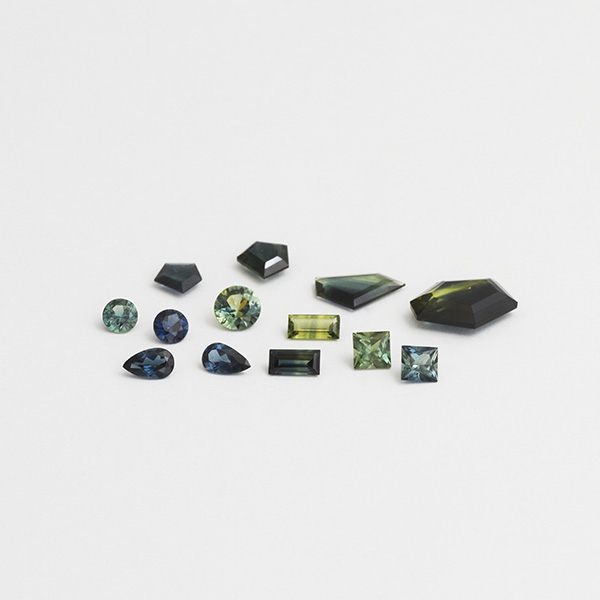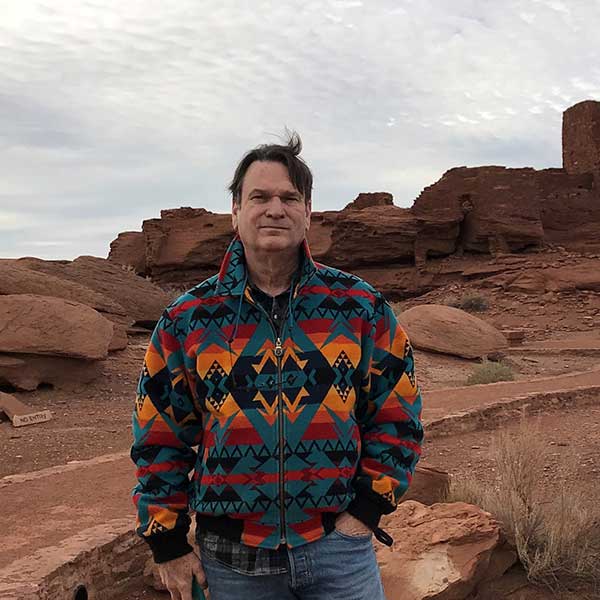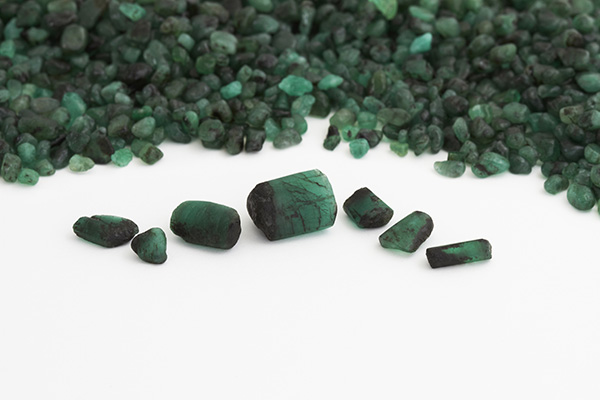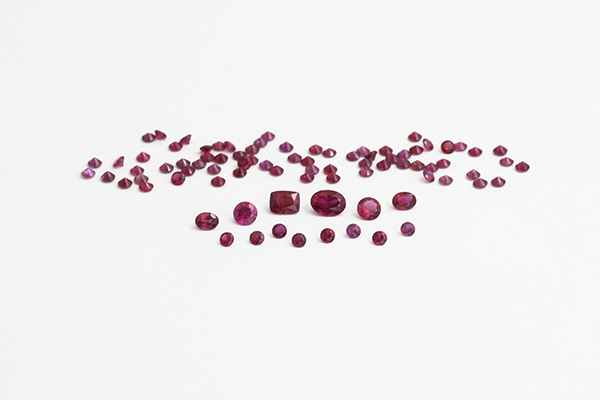
Eric Braunwart, founder and president of Columbia Gem House, a well-regarded gem-cutting operation based in Vancouver, Wash., has spent the better part of the past two decades pioneering his company’s approach to sustainability and traceability. (In 2004, Columbia Gem House started the industry’s first Fair Trade initiative.)

This year, the expertise Braunwart has acquired in understanding—and improving—his supply chain will be front and center at the AGTA GemFair at the Tucson Convention Center. That’s where Columbia Gem House will introduce three new gems it describes as “purposeful” in its marketing: Australian sapphire, Brazilian emerald, and a new ruby from Madagascar known as Pomme ruby because it’s mined in an area dotted with apple and rice farms (pomme means “apple” in French and is the root word for apple in Malagasy).
JCK spoke to Braunwart in mid-December to gauge his expectations for the colored stone market in 2023 (pretty darn good, all things considered). In the process, he explained how Columbia Gem House determines the Fair Trade Gem “level” it assigns to each of its stones, the impact that Pantone’s Color of the Year typically has on sales, and why he dislikes the term ethical sourcing.
The interview has been edited for length and clarity.
What’s your take on the colored stone marketplace as we come into the new year?
Our customers are feeling pretty good. We’ve been trying to talk to the bigger customers—the manufacturing customers—about planning for next year, and most of them have had a good enough year. They’re planning for 15%–25% growth in 2023.
Our biggest customer sent us an email—because we have a certain product you can only mine at a certain time of year—and asked, “Can you stock extra because we expect our sales to be up 25% for ’23.”
I sort of think they’re right. We’ve bought a lot of rough because we think we’re going to need it.
What is your expectation for the gems shows in Tucson?
Last year, we set a fairly aggressive number for Tucson and we beat it by 60%. This year, we’re not setting as high a target as we did last year, but it still will be an aggressive number over a traditional Tucson.
We’re not sure what the show will be like. The Chinese haven’t been buying there for three years. Indians generally haven’t been buying there. China’s dropped its COVID policy, but the Chinese market is way down. So many unknowns out there. We think it will be good, but will be as good as last year?
People are generally going in expecting a good show, not necessarily a record show, but they’re not expecting it to tank.
Tell us about the new gems you’re bringing to Tucson. What’s the Brazilian emerald all about?
We’ve worked pretty hard to set up a traceable, supportive supply chain for emerald. The first groups are in cutting now. It’s not top Colombian emerald or anything like that, but we think it will be nice and green in small sizes. It’s from a smaller family mine in the Brazilian state of Bahia and a group of smaller mines that do a co-op with them. They would be thrilled if we would promote their mining activities.
A friend of mine, Brian Cook from Nature’s Geometry, went to the mines and helped set it up, and it looks pretty positive. Getting into emerald is fairly new for us, at least the way we’re trying to get into supply chains.

How would you describe your approach to supply?
Broadly in the industry, it’s referred to as “ethical supply chains,” which I really dislike. I don’t think the term at all explains what we and some other people are trying to do. We’re trying to find ways to better support everybody along the supply chain. One group we work with, for example, their production went way down. They can’t mine during rainy season because the mine gets flooded, so we funded pumps for them so they could continue to mine. That adds three to four months to their production.
Yes, we trace our supplies. But when people say, “Our mines are great and ethical because we trace them,” they’re not ethical because you trace them. You trace them to understand the positives and negatives along the supply chain, and you try to accentuate the positives and right the negatives. The best term I’ve come up with is supportive supply chains.
You look at the cutting—where and how it’s cut—but instead of stopping there, we need to look at the rough. Where was it produced? Just knowing that tanzanite came from Tanzania, but not knowing if it was smuggled or exported legally—just knowing where it’s from is not the solution. It’s looking at the different steps and seeing how they’re going.
You’re also showing a new ruby from Madagascar, which you introduced at AGTA GemFair Denver in September.
Ruby is not new to us but this ruby out of Madagascar, from a rice and apple farming area, is. When they’re not farming, they have a co-op area where they all can dig and negotiate prices with a buyer.
The material looks fairly easy to cut and process. But getting it has been a challenge. Twelve months ago, the government caught a bunch of people smuggling so they stopped export of rough and cut stones.

I take it the logistics around your new supply of Australian sapphire have been easier to handle. Tell us about that.
The production in northern Australia, in the state of Queensland, is up and in New South Wales, where the traditional blue sapphire is mined, it’s way down. The reason Queensland is up is because of the iPhone. It’s the same reason we can sell Montana sapphire now.
Before 2006, if I went to a retailer with a teal sapphire or a lime green sapphire, they would tell me, “I wouldn’t stock that.” But because of the iPhone, people would see pictures of nontraditional-looking sapphires and say, “I didn’t know sapphire came in green!” That’s what’s made the Montana industry and the Queensland industry because Queensland doesn’t produce blue sapphires; they produce teals and greens.
It’s all changed over an 18-year period and particularly in the last five to six years. So we have a lot of Australian sapphire rough. We were working with Great Northern Mining, the big sapphire mining operation in Australia, for about five to six years, and we were watching them dig it and it was going to a company in the U.S. The company went bankrupt and we found 350 kilos that had been sitting around over the last 25 years, so we went and bought it. We’d always cut Australian—we were developing the heat treating for Great Northern almost 30 years ago now—so this is just in addition to what we’ve had. We’ll be showing quite a bit of it. I wish there were more bicolors; there is bicolor but not as much as we’d like. The designer market really likes bicolor.
The advantage is: There’s quite a market for small stones in general. Designers are not using giant expensive stones like one-of-a-kind designers. This Australian sapphire gives us the ability to do a thousand teal kite-shape stones—not a thousand 5-caraters—but we have the rough to back that up.
Can you explain how you determine the “Fair Trade levels” you assign to each gem in the Columbia Gem House stable?
We have these different levels of traceability that refer to how much we know about the production. If, for example, we know the gem was produced in Liberia and exported legally, it would be a 3.
In Australia and in the U.S., it’s pretty easy to know how a gem was produced. Both countries have tough laws. And they generally fall into our category 1. Whereas most developing nations, we struggle to get them above a 3. We don’t really need that rough, but we don’t think we should be abandoning these countries, which just widens the wealth and education gap. So we keep working in these countries even though it’s very difficult.
Level 4—tanzanite is an example. You know it came from Tanzania, but it’s just a parcel that shows up in Tucson, and you know nothing else about it. But then we would cut it. We know nobody’s going to die at the cutting facility. That would be a 4. We don’t buy that kind of rough anymore. Level 5 would be we just bought a cut stone because I liked it, which we don’t do anymore either.
A Level 2 would be a 3 we’ve been able to move up. We have an export document we ask our suppliers to fill out. It talks about the conditions of how the gem was mined, and we ask them to attach pictures where possible. But we can’t say exactly where it was mined.
Are you bringing anything else that’s new to Tucson?
Some odd things, like gem rhodonite, which nobody’s ever heard of. It’s usually an opaque rose-colored stone and a few years ago in Brazil somebody found a new deposit that was crystalline and that’s what this is. It’s very much like the Color of the Year.
Does Pantone’s Color of the Year actually move product?
I don’t think it does in a specific color range. But in a broad color range, yes. For 2023, it may start bringing more jewel tones back into the market. Rich, beautiful colored amethyst hasn’t sold for years. These beautiful garnets that come close to Pantone’s Viva Magenta are the best buy on the market. We’re hoping it will generate interest in some of those darker, richer jewel tones. We don’t think it will kill the pastel movement we’ve seen in the last couple years, but it would be nice if it broadened the palette.
Any final thoughts or advice for buyers headed to the gem shows?
If you see a stone or type of stone you really love, just buy it. Because right now supply chains are still really messed up. Also, if you’re doing any repeatable goods, talk to the company and see how repeatable they’re going to be. Can they deliver stones monthly at a fixed price? So many people buy stones they love and put them in repeatable mountings and find out they’re not repeatable.
If you’re doing one of a kinds, I’m not joking when I tell people, when you see one, buy it. I don’t know when, if, or how some of these supply chains will get back to normal—or if there even is a normal.
Top: A selection of Australian sapphires cut by Columbia Gem House
- Subscribe to the JCK News Daily
- Subscribe to the JCK Special Report
- Follow JCK on Instagram: @jckmagazine
- Follow JCK on X: @jckmagazine
- Follow JCK on Facebook: @jckmagazine







